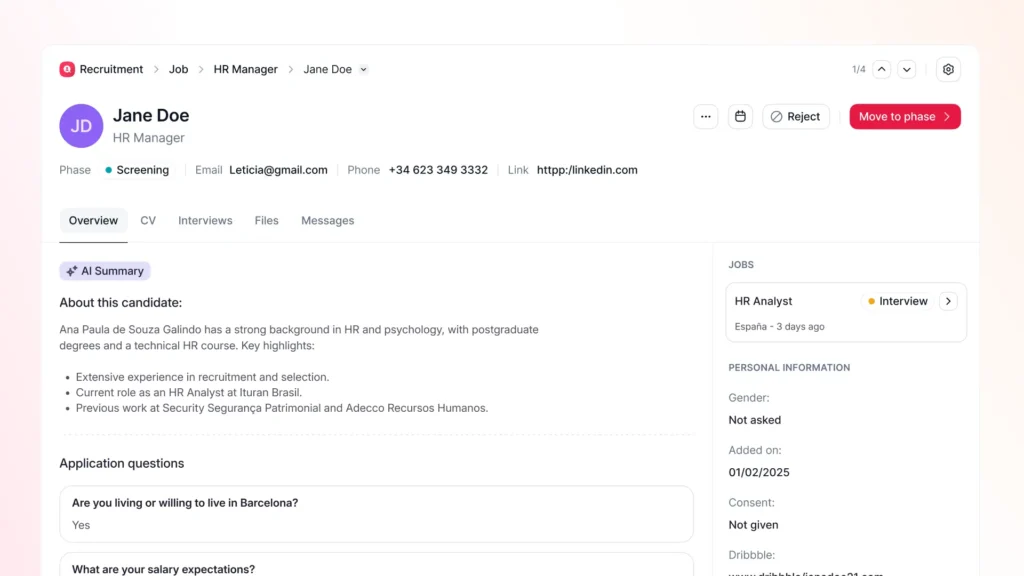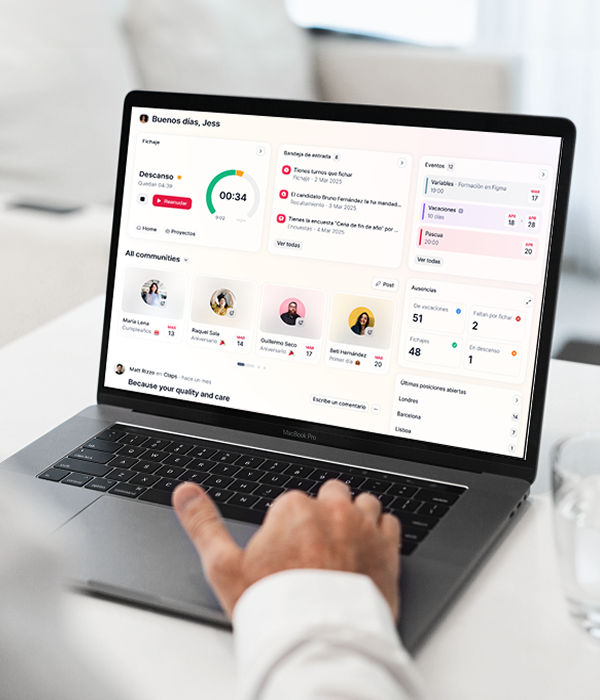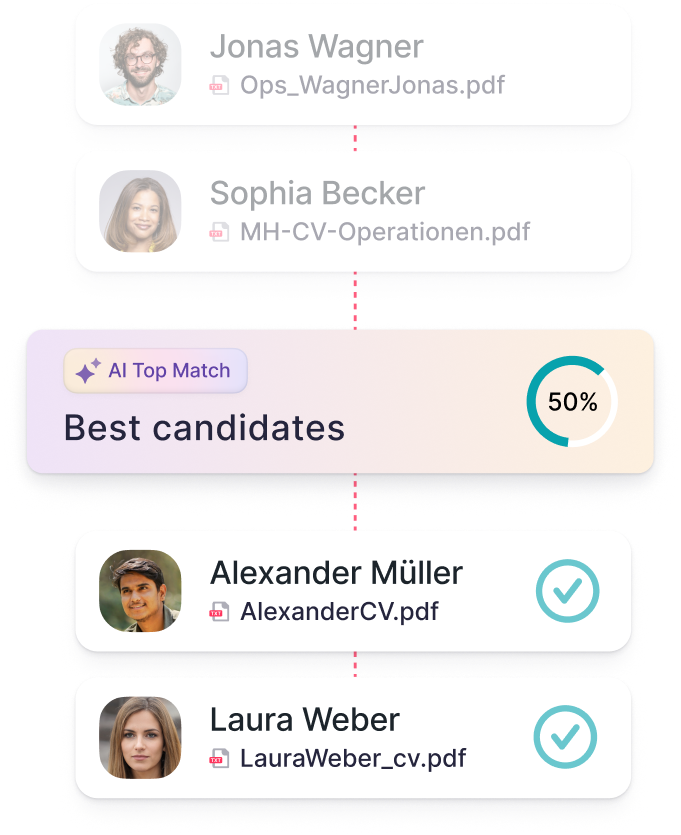Building a reliable talent pool is one of the most important foundations of hiring successfully. With competition for skilled workers rising and workforce needs shifting quickly, HR managers and business owners need a way to stay connected with qualified candidates before a job even opens. An organized talent pool helps you find the right people faster, reduce hiring costs, support diversity and inclusion recruitment best practices, and create a better experience for every single candidate who interacts with your company.
In this guide, you will learn what a talent pool is, how talent pool management works, and how to build a strong and diverse multigenerational talent pool using clear steps and the right tech. Later in the article, you will also find tools and resources, including a free hiring process checklist, to help you put these ideas into practice.
What is a talent pool?
A talent pool is a structured collection of candidates who might be a good fit for future job openings at your organization. These are jobseekers who may have applied before, shown interest through events or employee referrals, or been identified during other sourcing efforts. They are not active applicants for a specific role, but they represent a group of people you may want to contact when the right opportunity appears.
Managing a talent pool means organizing these candidates, updating their information, and keeping them engaged so you can reach out quickly when a position opens. This process is known as talent pool management. When it is done well, it helps HR teams stay ahead of hiring needs instead of rushing to find talent at the last minute. Strong talent pool management also supports better talent attraction strategies because it expands your reach and helps you stay visible to skilled candidates before you need them.
A talent pool often includes people with a variety of backgrounds, experience levels, and career goals. This can help your company build a diverse and multigenerational talent pool that reflects different perspectives and strengths. Tracking skills, interests, and experience helps HR teams match candidates to future roles more accurately and support skills-based hiring across the organization.
What is the difference between a talent pool and a talent pipeline?
Although the terms are often used together, a talent pool and a talent pipeline serve different purposes in talent acquisition. Understanding the difference helps HR managers design a clear talent attraction strategy and use their resources more effectively.
A talent pool is broad. It includes anyone who could be a potential fit for future roles. These individuals may not be tied to a specific opening, and they may or may not be actively looking for a new job. A talent pool focuses on long term readiness and relationship building.
A talent pipeline, however, is narrower. It includes candidates who are already being prepared or evaluated for a specific role or group of roles. These individuals typically meet the core requirements, are actively engaged, and are more likely to move into the hiring process via the recruitment funnel sooner.
Below is a simple chart to show the differences between a talent pool and talent pipeline.
Talent Pool vs. Talent Pipeline
| Category | Talent Pool | Talent Pipeline |
| Definition | A broad group of potential candidates who could fit future roles. | A smaller group of candidates being actively prepared for a specific role. |
| Purpose | Build long term relationships and expand potential hiring options. | Ensure a ready group of qualified candidates for immediate or upcoming openings. |
| Sources | Former applicants, sourced candidates, event contacts, referrals, passive talent. | Prequalified candidates who meet the requirements for a specific job or job family. |
| Stage of Hiring | Early stage or pre-hiring. | Mid or late stage, close to active recruitment. |
| Engagement Level | Occasional check-ins and updates. | Frequent communication to prepare for interviews and hiring decisions. |
Both a strong talent pool and a well-maintained talent pipeline are essential for success in talent acquisition. The pool keeps options open and diverse, while the pipeline supports fast and focused hiring.
Benefits of a diverse talent pool
Building and maintaining a diverse talent pool has multiple benefits for HR managers and business owners. A talent pool that includes candidates of different backgrounds, experiences, and age groups, in other words a multigenerational talent pool, helps companies stay competitive and innovate faster. Here are the main benefits:
1. Reduce cost per hire and time to hire
By having prequalified candidates ready, you can fill roles more quickly and efficiently. This reduces the time to hire and money spent on sourcing, advertising, and screening new applicants. Using talent pool management software can streamline these processes even further.
2. Increase retention
A well managed talent pool allows you to match candidates to roles where they are most likely to succeed and stay long term. Engaged candidates from a talent pool are more likely to accept offers that align with their skills and career goals. This helps improve retention.
3. Improve candidate experience
Keeping candidates informed and engaged, even if a role is not immediately available, shows that your company values their time and interest. A positive experience can enhance your employer brand and attract more high quality candidates over time.
4. Support diversity and inclusion recruitment best practices
A diverse talent pool ensures that you are considering candidates from different backgrounds, industries, and generations. This helps reduce hiring bias in decisionmaking and strengthens your company culture.
📌 Read more on how to remove gender bias in the recruitment process.
5. Enable strategic workforce planning
A talent pool allows HR teams to anticipate future hiring needs, plan for skills gaps, and align recruitment with business objectives. It becomes easier to implement a long term talent attraction strategy and support a broader talent acquisition platform.
6. Facilitate skills based hiring
By tracking candidate skills and competencies, a talent pool helps you focus on the abilities that matter most for each role. This approach goes beyond traditional resumes and job titles, allowing you to identify talent that may otherwise be overlooked.
A diverse, well managed talent pool is an important part of recruiting and essential for a successful talent acquisition strategy.
📌 Read more on DEI recruitment best practices.

Step-by-step guide to building a talent pool
Creating a strong talent pool requires careful planning and ongoing management. Here is a clear guide HR managers and business owners can follow to build a diverse and effective pool.
1. Define your organizational needs and scope roles
Before sourcing candidates, identify the positions and skills your company will need now and in the future. Consider both technical skills and soft skills. Planning ahead ensures your talent pool aligns with business goals and workforce strategy.
Read more on how a healthy talent pool contributes to succession planning at your organization.
2. Source your candidates
Attract potential candidates from multiple channels. This can include former applicants, referrals, networking events, social media, industry communities, and job boards. Keep in mind that a multigenerational talent pool includes individuals from a variety of backgrounds and experience levels.
3. Segment your talent pool
Organize candidates based on skills, experience, role type, location, or other relevant criteria. Segmentation makes it easier to match candidates to future positions quickly. Using talent pool management software can simplify this step by centralizing candidate information and allowing filters for specific needs.
4. Engage and nurture candidates
Keep potential hires informed and interested in your company. Send updates, newsletters, or invitations to company events. Engagement helps maintain relationships and ensures your talent pool stays active. However, make sure to only send them content that they will find interesting.
5. Refresh and requalify the pool regularly
People’s skills and availability change over time. Periodically review your talent pool to remove inactive profiles and update candidate information. Requalifying candidates keeps your pool relevant and ready for new opportunities.
6. Implement diversity and inclusion best practices
Ensure that your sourcing and engagement strategies reach a wide range of candidates. Consider diversity in age, gender, ethnicity, experience, and educational background to create a more inclusive talent pool. This strengthens company culture and innovation.
7. Track and measure effectiveness
Use metrics such as engagement rates, time to hire, and retention to evaluate the success of your talent pool strategy. This allows HR teams to adjust sourcing methods and engagement tactics for continuous improvement.
Following these steps can help you build a talent pool that not only supports immediate hiring needs but also contributes to long term talent acquisition goals.
Talent pool software
Managing a talent pool manually can be time-consuming and it is easy to overlook certain errors. Talent pool software helps HR teams organize, engage, and track candidates more efficiently, turning a large collection of potential hires into a strategic recruitment resource.
1. Centralized candidate information
Talent pool software stores all candidate profiles in one place. This makes it easy to add, update, filter, and sort candidates. Bulk CV uploads allow you to add multiple applicants quickly, saving time and reducing administrative work.
2. Better candidate segmentation and search
Most talent pool tools let you tag candidates by skills, experience, location, or other criteria. Tags make searching and filtering faster, support consistent evaluations across hiring teams, and allow recruiters to match candidates to roles more effectively.
3. Streamlined workflow
Talent pool software often integrates job postings, messaging, and tracking into a single platform. This reduces manual tasks, ensures teams can collaborate easily, and keeps candidate interactions organized.
4. Engagement and communication tools
Many platforms include features for automated emails, bulk messaging, and scheduled follow ups. These tools help maintain relationships with potential hires, keeping your talent pool active and candidates engaged until the right opportunity arises.
5. Analytics and reporting
Talent pool software provides insights on key hiring metrics such as candidate sources, engagement rates, and diversity trends. This data allows HR teams to make informed decisions, improve their talent pool management, and plan future recruitment strategies effectively.
6. Support for diversity and skills-based hiring
By tracking skills, experience, and other attributes, talent pool software helps companies focus on competencies rather than just resumes. This supports fairer evaluations and helps build a more diverse and multigenerational talent pool.
Using talent pool software ensures that HR teams spend less time on administrative tasks and more time connecting with the right candidates. It also makes long-term workforce planning more strategic, scalable, and data driven.
How Factorial can help your recruitment process
While talent pool software in general helps organize and engage candidates, Factorial offers a platform that combines these features with tools to make the entire recruitment process easier for HR teams and business owners.

Centralized candidate database
Factorial keeps all candidate information in one place, including resumes, evaluations, and communication history. You can filter and sort candidates by skills, experience, or other tags, making it simple to find the right people for current and future roles. This helps maintain a multigenerational talent pool and supports diverse hiring initiatives.
Streamlined hiring workflow
Jobs, applications, and messaging are managed in a single hub. Hiring managers can track candidate progress, leave feedback, and collaborate with team members without juggling multiple tools. This reduces manual work and ensures a smooth recruitment process.
Automated engagement and communication
With bulk messaging, templates, and scheduled follow-ups, Factorial makes it easier to keep your talent pool active and engaged. Candidates stay informed about opportunities, improving the overall candidate experience and helping you attract top talent.
Data-driven insights
Factorial provides analytics on metrics such as time to hire, pipeline conversion, candidate sources, and diversity trends. These insights help HR teams measure the effectiveness of their talent pool management, refine recruitment strategies, and make more informed hiring decisions.
Supports skills based hiring and inclusion
By tracking candidate skills and experience, Factorial allows recruiters to evaluate candidates more objectively, focusing on competencies rather than just job titles. This approach supports skills based hiring and diversity and inclusion recruitment best practices, ensuring a fairer and more effective hiring process.
Scalable for growing businesses
Factorial is suitable for small and medium-sized businesses that need to manage multiple roles and candidates efficiently. Its applicant tracking system integrates with broader HR processes, making talent pool management more organized, flexible, and strategic.
Using Factorial, HR teams can keep their talent pool organized, engage candidates consistently, and make recruitment faster and more effective while supporting long-term workforce planning.
Get started on building your talent pool
A well-maintained talent pool is one of the most valuable assets for recruitment. It allows HR teams to engage candidates early, reduce time and cost per hire, improve retention, and support diversity and inclusion recruitment best practices. Using Applicant Tracking Software makes it easier to organize candidate information, track engagement, and make data-driven hiring decisions.
To put these strategies into practice, it helps to have a clear, step-by-step guide. Factorial offers a free Hiring Process Checklist that helps HR teams plan every stage of recruitment, from defining roles to managing candidate engagement and analyzing results. Download and follow the checklist alongside your talent pool management efforts for a smooth, efficient, and consistent hiring process.
Combine a structured talent pool with the right software and tools, so your business can create a proactive, strategic approach to hiring. This makes it easier to attract the right candidates, keep them engaged, and build a workforce that meets both your current and your future needs.
Talent Pool FAQs
1. What is the difference between a talent pool and a talent pipeline?
A talent pool is a broad group of potential candidates who could fit future roles. A talent pipeline is a more focused group of candidates actively being prepared or evaluated for specific roles. Pools are used for long term planning, pipelines for immediate hiring.
2. How big should a talent pool be for employers?
The size depends on your industry and hiring needs. Smaller companies may keep a few dozen highly qualified candidates per role, while larger organizations may manage hundreds. The key is to focus on quality and relevance.
3. How often should you engage the pool?
Engagement should be regular but not overwhelming. Quarterly updates, newsletters, or invitations to company events help maintain relationships and keep candidates interested until the right opportunity arises.
4. What data can employers store and for how long in the US?
Employers can store resumes, contact details, and interview notes. Retention periods vary by state and purpose, but a common guideline is one to two years unless the candidate consents to longer storage. Always ensure compliance with privacy laws.
5. What is the best talent pool management software for SMBs?
Software like Factorial is ideal for small and medium sized businesses. It centralizes candidate information, supports tagging and segmentation, automates communication, and provides analytics for better hiring decisions. It integrates talent pool management into a broader talent acquisition platform, making recruitment more efficient and strategic.




